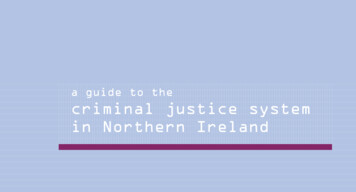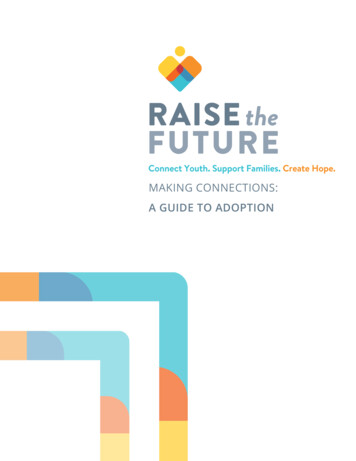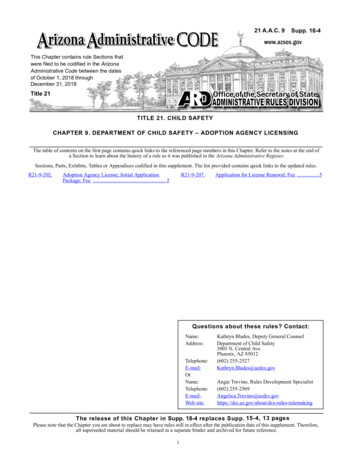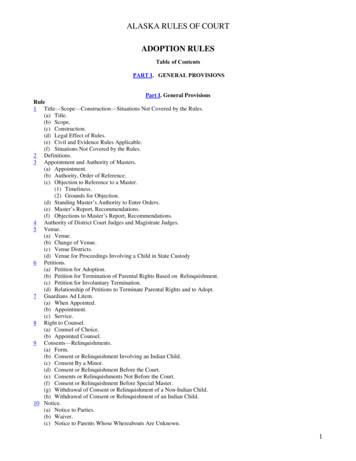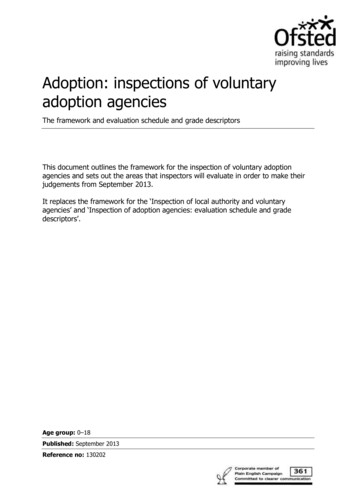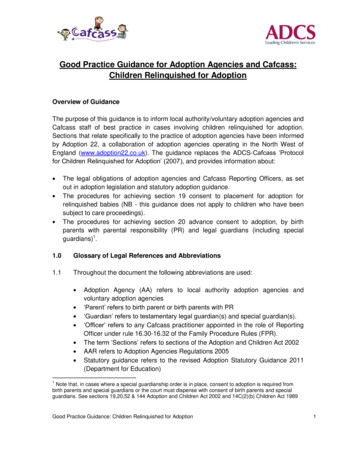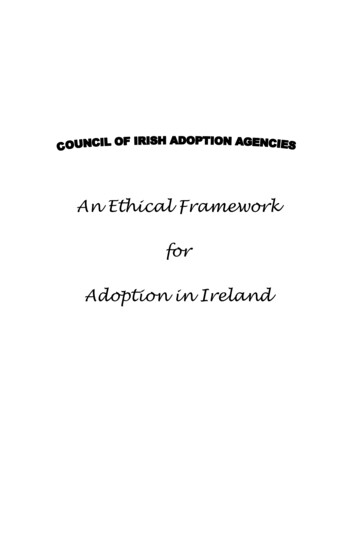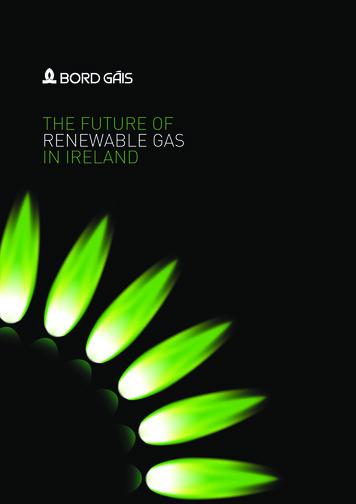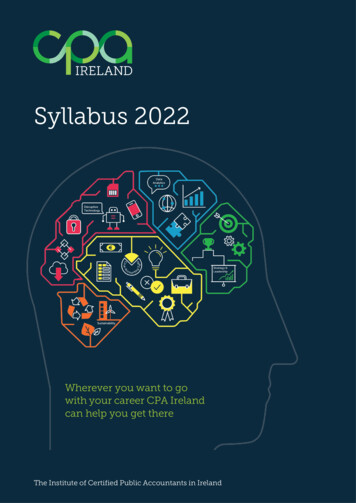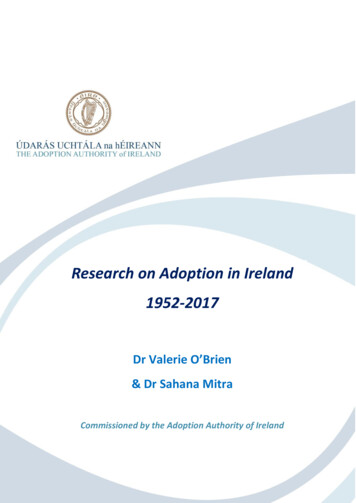
Transcription
Research on Adoption in Ireland1952-2017Dr Valerie O’Brien& Dr Sahana MitraCommissioned by the Adoption Authority of Ireland
AN AUDIT OF RESEARCHON ADOPTION IN IRELAND –1952–2017October 2018Authors:Dr Valerie O’Brien, School of Social Policy, Social Work and SocialJustice, UCD.Dr Sahana Mitra, School of Social Policy, Social Work and SocialJustice, UCD.Commissioned by:Adoption Authority of Irelandii
ContentsContents . iiiAcknowledgements . viAbbreviations Used in this Report . viiList of Tables . viiiList of Figures . viiiPART I . 1INTRODUCTION . 1Purpose of the Audit . 2Awarding of the Contract and Time Frames . 2Main Methodology Used . 3Report Structure . 3PART II . 4METHODOLOGY . 42.1Research Objectives . 42.2Positioning and Experience of Authors as Influence . 42.3Methodology and the Method . 62.4Summary . 27PART III . 29DATA ON ADOPTION RESEARCH RESULTS . 293.1Overview of Adoption Research Results . 293.2Findings Related to ‘Books’ Search . 313.3Findings Related to ‘Journal Articles’ . 323.4Findings Related to Government Publications . 343.5Findings Related to ‘Conference/Seminar Presentations’ . 353.6Findings Related to ‘Postgraduate’ Adoption Research . 373.7Findings Related to ‘Best Practice’ . 403.8Findings Related to Advocacy. 41PART IV . 44THEMATIC ANALYSIS -. 44THE NATURE OF THE RESEARCH EVIDENCE IDENTIFIED . 44iii
4.1Introduction to Analysis. 444.2Thematic Analysis. 454.3Conclusion . 72Part V. 73CONCLUSION ON ADOPTION RESEARCH GAPS . 735.1Introduction . 735.2Summary of Existing Adoption Research . 745.3Towards the Identification of Research Gaps . 805.4The International Context . 825.5Specific Recommendations. 825.6Development of an Irish Research Strategy . 905.7Conclusion . 92REFERENCES. 93BIBLIOGRAPHY OF BOOKS (1952–2017) . 100BIBLIOGRAPHY OF JOURNAL ARTICLES (1952–2017) . 108BIBLIOGRAPHY OF GOVERNMENT DOCUMENTS (1952–2017) . 115BIBLIOGRAPHY OF CONFERENCES/SEMINARS (1952–2017) . 123BIBLIOGRAPHY OF POSTGRADUATE THESES: M.A, M.SC, M.LITT, LL.M, M.PHIL, PhD (1952–2017) . 127LIST OF APPENDICES . 132APPENDIX A . 133Audit of Irish Research - Tender Issued by the Adoption Authority of Ireland . 133APPENDIX B . 135Notification flyer sent to professionals through professional associations requesting details of researchundertaken. 135APPENDIX C . 137Tables outlining individual studies contained in six main themes . 137BIRTH PARENTS . 138ADOPTED PEOPLE . 143ADOPTIVE PARENTS . 147POLICY . 153LAW . 158iv
SERVICE PROVISION. 166APPENDIX D . 171Excel Sheet of Adoption Research from 1952 to 2017. . 171Please see electronic file and accompanying document . 171APPENDIX E . 172Table showing the list of keywords to search the studies in the Excel sheet . 172v
AcknowledgementsWe extend our gratitude to all who contributed in so many ways to the preparation of thisreport. Firstly, we would like to thank all the academics, researchers and staff of Irisheducational institutions and various agencies that responded to our emails and shared theirresearch work. We would particularly like to thank the postgraduate research students whohave recently graduated or are currently pursuing their degrees for sharing their material withus. Without your help, it would have been difficult to complete this audit. Much appreciationis also extended to Dr Maureen Lyons, Research Manager and Dr Nessa Winston at the UCDSchool of Social Policy, Social Work and Social Justice for their ongoing support andencouragement.We would also like to extend our thanks to Dr Marta Bustillo, the Liaison Librarian, Collegeof Social Science and Law, UCD, for her support. Marta was immensely helpful and was ofparticular assistance in the generation of search terms and locating theses. She was especiallykind when breaking the news that much of the research documentation we were seeking wasnot available electronically or held in libraries!Furthermore, the complex field of adoption research was made easier to understand with theassistance of social workers and administrators in the Council of Irish Adoption Agencies, theAdoption Authority of Ireland, the Irish Association of Social Workers and the AdoptionRights Alliance. They provided excellent guidance, shared detailed information, andencouraged us in our work.The research committee of the Adoption Authority of Ireland was very helpful with theirinput. Particular thanks to the Chairperson, Dr Helen Buckley, Ms Celia Loftus, PrincipalSocial Worker and Mr Ronan Keegan, Social Worker, who provided us with guidance andfacilitated various processes. Likewise, we wish to extend our thanks to the researchcommittee and peer reviewers.Finally, any research journey is arduous and requires the support of friends and family, and ateach stage of this research, our focus towards completion of this audit work was supported byour family and friends. We would also like to thank Ms Angela Palmer, who has been anaccommodating editor, despite her stringent schedule as a doctoral student herself.vi
Abbreviations Used in this ReportAAIAdoption Authority of IrelandARAAdoption Rights AllianceCCIAACentral Council of Irish Adoption AgenciesCRAChildren’s Rights AllianceDADomestic AdoptionDCYADepartment of Children and Youth AffairsDoHDepartment of HealthEAEquality AuthorityHBHealth BoardIASWIrish Association of Social WorkersICAIntercountry AdoptionIVFIn-Vitro FertilisationHSEHealth Services ExecutiveLRCLaw Reform CommissionSWSocial WorkerWHBWestern Health Boardvii
List of TablesTable 1: Search Terms Used in the AuditTable 2: Social Science Databases Searched for Irish Adoption ResearchTable 3: Databases Searched for Legal Documents, Research and Government Reports inRespect of Irish Adoption ResearchTable 4: Irish Journals Searched for Irish Adoption ResearchTable 5: List of Educational Institutions, Non-Governmental Organisations and PublicInstitutes Searched and ContactedTable 6: Templates Schema Used for Data ExtractionTable 7: Categorisation of the Data into Different Sections Across Decades (1952–2017)Table 8: Access to Abstracts/Theses of Postgraduate Research Completed from 1952 to 2017List of FiguresFigure 1 Conceptual Framework Developed to Guide the Thematic Analysis in the AuditFigure 2: Conceptual Framework Used to identify Gaps Arising from Thematic AnalysisFigure 3: Books/Book Chapters Published 1952–2017Figure 4: Peer Reviewed and Non-Peer Reviewed Journal Articles published 1952–2017Figure 5: Government Publications 1952–2017Figure 6: Research Papers Presented at Conference & Seminars for the period 1952–2017Figure 7: Completed Theses and Ongoing In the Field of Adoptions in Ireland for the period1952–2017Figure 8: A Conceptual Framework to Identify Research Gaps Arising From ThematicAnalysisviii
PART IINTRODUCTIONA request for tenders for the development of an audit of Irish research and an overview ofpolicy and legislative change in relation to adoption was issued by the Adoption Authority ofIreland (AAI) in February 2017 (See Appendix A – Adoption Authority of Ireland TenderDocument 2017).There were two parts in the request outlined in the Tender documentation (AAI TenderDocument 2017: p. 1). The objectives of Part 1 as set out by AAI were as follows:1. Identify completed and ongoing research across a range of disciplines in relation toadoption;2. Audit the literature with a view to producing a written report and an Excel sheet toassist with the development of a typology/database (e.g. type of study, author, year,title, type of publication, sources of information, topics covered, sources of funding,link to website etc.);3. Identify gaps in the Irish research literature on adoption.The objective of Part 2 was as follows:To produce an overview, between 5,000 and 7,000 words, of the development ofadoption legislation, policy and practice since 1952, and up to the start of 2017. Theoverview was required to be: ‘written in a narrative style, and provide a brief analysisof the origins, impact and implications of the different changes’ (AAI TenderDocument 2017: p. 1).AAI outlined that the audit should be based on material which should be research based andanalytical in nature, have adoption as a primary focus and have been conducted usingqualitative, quantitative or mixed methodological approaches. This was to include: articles in professional journals (peer reviewed and non-peer reviewed); peer reviewed conference and symposia papers; commissioned research undertaken by consultants and researchers; systematic research undertaken by government departments, agencies or independentpublic bodies;1
relevant postgraduate research. (AAI Tender Document 2017: p. 2).For the purposes of the project, ‘research’ was defined as: the process of systematic enquiry aimed at answering questions and/or exploringphenomena using scientific methods (employing quantitative, qualitative and/ormixed methods/approaches); these methods may draw on the whole spectrum ofsystematic and critical enquiry to allow interpretation of data in answering specificquestions and/or posing new questions for future research (AAI Tender Document2017: p. 1). the definition was extended to include documentary analysis, that is, systematicprocedure for reviewing or evaluating documents – both printed and electronic(computer-based and internet-transmitted) material (Bowen, 2009) about thephenomenon one wishes to study (Bailey, 1994). Under this kind of analysis, the datais examined and interpreted in order to elicit meaning, gain understanding, anddevelop empirical knowledge (Corbin & Strauss, 2008; Rapley, 2007). Documentarymaterial used included literature reviews, existing data sets and critical commentaryon the topic of Irish adoption.Purpose of the AuditIt is intended that this report on the audit of adoption research will assist in informing thefuture research strategy of the Adoption Authority of Ireland.Awarding of the Contract and Time FramesIt was indicated in the request for tender documentation that the project should be completedwithin three months of a contract being signed. The outcome of the tender was announced on15 May 2017; a meeting was held between Dr Valerie O’Brien and the research subcommittee on 15 May 2017 to discuss the research parameters further. A contract was signedby Dr Valerie O’Brien on behalf of UCD and Ms Patricia Carey, CEO of AAI. It was agreedthat the work would commence in late August. Following the signing of the contract and thecommencement of the work, permission was requested to submit the draft report in December2017 instead of November 2017. The reasons for this extension of the time frame arediscussed in the methodology section (Part II) of this report.2
Main Methodology UsedThere were two ways that the research work for the audit was approached. The intended shorttime frame was a major factor in the audit design.In the first level, the relevant data was screened, collected and organised through a ‘step-bystep method’. This helped us to organise the data into different categories as proposed in thetender, which included books, government publications, peer and non-peer reviewed journals,conference papers, and postgraduate research work. This approach is detailed in Part II of thisreport.In the second level, following the identification and collection of the above data, a broadthematic analysis of the abstracts of the studies was carried out. This enabled us to synthesisethe body of work and to identify gaps in research knowledge. A thematic analysis provided awell-structured approach to handle the data (King, 2004), report the themes found within thedata set (Braun & Clarke, 2006) and to produce a summary report. The details of the thematicanalysis are discussed in Part IV of this report.Both these methods facilitated the identification, examination, analysis of research data andidentification of research gaps in Irish adoption literature.Report StructureThe report is presented in five parts as follows. The introduction, Part I outlines thebackground to the tender and includes the research objectives and parameters. Part IIdescribes the methodology used in the work. The methodology outlines the search termsused, search strategy, databases utilised and the method of review and analysis undertaken.Our position as researchers and the limitations of the work is also discussed. Part IIIhighlights the results generated through the step-by-step method utilised. The findings aredepicted with the help of tabular and graphical representations. Part IV presents the resultsgenerated through thematic analysis. Part V concludes the report, identifies research gaps inthe literature and suggests a number of recommendations for future research that may assistthe Irish adoption system and community.3
PART IIMETHODOLOGYThis section of the report describes the research design used to achieve the researchobjectives established by the Adoption Authority of Ireland. The processes involved in the‘step-by-step’ method in respect of data collection, categorisation and data extraction areoutlined. The categorisation and analysis of the data through a thematic analysis is alsodetailed. The researchers’ positioning and experience of adoption as an influence on theresearch is considered. Finally, the limitations of the work are discussed.2.1Research ObjectivesThe research objectives were outlined by the Adoption Authority of Ireland in the Invitationto Tender document, as outlined in Part I. The aim of the tender was to identify and audit theresearch literature on the topic of Irish adoptions, as well as to identify and document thegaps which exist in this area of research.2.2Positioning and Experience of Authors as InfluenceReflexivity is central to the research process. The entire process of exploring and knowingour own biases, attitudes and knowledge base towards the research was discussed at variousstages over the course of the work to arrive at a situation where the research objectives couldbe achieved. A position of curiosity, identification of our various viewpoints, a respecttowards differences and similarities were important stances which guided our co-work andactions in this project. We placed strong emphasis on ‘insider–outsider positioning’. In recentyears, the notions of insider and outsider have evolved where either of the researchers is‘neither fully inside nor outside’ (Milligan, 2016: p. 239). The position of the researcher isalways fluid as it depends both on the situational influence and the interaction with andamong the people in the field, who either see the researcher as insider or outsider (Katyal &King, 2011; Thomson & Gunter, 2010). In relation to our study, the fluidity in our positioningwas already influenced by having worked together on previous projects (O’Brien & Mitra,2015) as well as on the Irish-Indian adoption study (Mitra & O’Brien, 2018a, b). Thisprevious work had established a good working relationship between both researchers and alsoknowledge and familiarity with the field of adoption in Ireland made Dr Mitra less of an4
outsider. The insider–outsider positioning was seen to provide a space where we couldquestion the taken-for-granted assumptions about our culture, its structure and policies. Thisknowledge was enhanced further throughout the field work with immersion in the Irishliterature. This all contributed to the researchers’ inter-cultural positioning and sensitivitytowards the research topic and created opportunities for observation, curiosity and reflexivityacross the various stages of the research process.This stance helped us as researchers to check our observations and also to explore if therewere levels of discrepancy between what the researchers thought they knew and what existedin the field of inquiry1. These reflections were noted down in a diary so as to be aware of the‘taken-for-granted’ assumptions while collecting, organising and reviewing the data.Therefore, both researchers made a list of actions that we were attentive to while reviewingand analysing the data. In the first instance we made explicit to one another our own positionand relationship with adoption. We had worked previously together in the adoption field andtherefore, we were able to build on that experience. On a technical level we put a number ofactions in place. We double checked the search terms with the librarian of the university, thenasked colleagues about the research which was available. This was followed by a process ofcontinual questioning of each other and ensuring both researchers were consistent in theirunderstanding of the processes involved.In reviews of this kind, it is essential to be aware of the knowledge and understanding of theconcepts at every stage of the review. For example, our understanding of the concept of‘primary’ and ‘secondary’ data sources, the definition of ‘research’, what constitutes ‘bestpractice’ and how to define ‘advocacy’ – were examples of processes and terms thatdemanded much reflexivity. The entire process of exploring and knowing our own biases and1As the research was conducted in Ireland and based on Irish research, it was evident that Dr O’Brien was moreof an insider in relation to the socio-cultural history of adoptions in Ireland, the contextual features of currentadoption as well as being the conduit to multiple stakeholder views. Dr O’Brien was a member of the IrishAdoption Board from 1998 to 2010. She has supervised various postgraduate researches and conducted researchin the field over many years and, moreover, had close connections to the academic and professional field. Herexperience became the starting point to establish contacts with faculty members and to generate a list of relevantinstitutions and organizations that could contribute to the review. On the other hand, the Indian researcher, DrMitra who started her research in the field of Irish adoption system as an outsider, over a period of time, becamemore of an insider to the field of Irish adoption. This was an outcome achieved by Dr Mitra working on theIndian-Irish adoption study prior to this audit. Prior to working in Ireland, she was an accomplished practitionerand researcher in the Indian adoption context.5
attitudes towards the research was discussed at various stages over the course of the work toarrive at a cohesive space where the research objectives could be achieved.2.3Methodology and the MethodSilverman (2000) defined methodology as ‘a general approach to studying research topics’(p. 88) which governs ‘how research should proceed’ (Harding, 1987: p. 2) and how theparticipants are heard and the text is seen (Fidyk, 2009). The methodology for the audit wasdescriptive, which helped to describe systematically and accurately the facts about the givenarea of study; to discover the associations between or among selected observable facts; and toanswer the questions based on the present context (Dulock, 1993). Under this methodology,the systematic review as a method to synthesise the data was proposed originally at the tenderstage to audit the Irish adoption research. As researchers, we began from an assumption,based on our prior knowledge and experience as researchers and clinicians in the field, thatthe cohort of Irish adoption research was small but that it could be accessed relativelyquickly. This, we believed would enable us to conduct a systematic review. This method ofreview was considered appropriate for the audit, based on the presumption of the small dataset that would be under review. Hence, it was our view that this could be achieved withinthree months, which was the envisaged timescale in the AAI tender documentation.In the initial stages of work, two significant issues related to the review and audit processemerged: First, there was very limited Irish research available in the electronic databases, andmuch of the information would have to be hand searched and consequently more timewould be needed in order to do so; Second, hard copies could not be located for much of the research that we hadidentified. We had to rely therefore on the synopsis of the research presented in searchengines, and to elicit information from professionals/academics in the field or dependon descriptions contained in other publications.In light of these constraints, it was apparent that a systematic review method was no longerfeasible. A review in that format would have taken 12 months to complete and was not inkeeping with the time frame indicated in the original tender document and the remaining timeavailable to us in which to complete the audit report. In view of these limitations, analternative method was required. Therefore, ‘a step-by-step sequential approach6
methodology’ was designed to systematically collect, map and appraise the research across arange of timescales and data sources. This was the first level of the analysis and was seen asappropriate in achieving the study objectives set out by AAI. This methodology included:(a) clarifying the research aim with the commissioners of the research;(b) identifying a set of research questions;(c) data collection including designing a set of inclusion and exclusion criteria;(d) data analysis aimed at eliciting the themes contained in the body of the research;(e) an ethical stance and attention to the positioning of the researchers was central to allstages.This method was considered appropriate for the purpose of screening, collecting, organisingand analysing the data which took account of the stated time frame and the scope of the work.This analysis brought a focus to ‘what has been researched’, ‘who has been researched’ and‘how it has been researched’. Following the data collection and mapping stage, we movedtowards the second level of the analysis where a broad thematic analysis of the audit researchwas carried out. Abstracts of the studies were used to carry out the thematic analysis reportedin Part IV because of the absence of the full texts of many works. The main purpose of theanalysis was to identify the gaps in the research. The step-by-step method and thematicanalysis are described in detail in Sections 2.3.1 and 2.3.2 respectively.2.3.1The Step-by-Step Method – First Level AnalysisThis section outlines the detailed steps involved in first-level mapping and analysis of thedata that included searching, screening, organising and categor
Adoption Authority of Ireland, the Irish Association of Social Workers and the Adoption Rights Alliance. They provided excellent guidance, shared detailed information, and encouraged us in our work. The research committee of the Adoption Authority of Ireland was very helpful with their input. Particular thanks to the Chairperson, Dr Helen .
